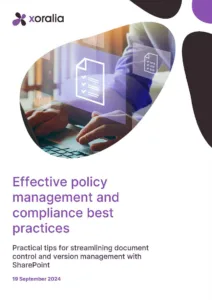5 key steps to enhance workplace policy compliance
- Dan Hawtrey

Compliance is critical for protecting an organization from legal and financial risks, maintaining its reputation, and ensuring smooth operations. To avoid compliance failure, organizations must implement robust policies and procedures, provide regular training, and utilize compliance management tools. These tools help monitor regulatory changes, track compliance status, and facilitate timely updates to policies and procedures. A proactive approach to compliance not only safeguards the organization but also fosters trust among stakeholders.
In this post we’re going to do a deep dive into policy compliance and the steps you can take to improve levels of compliance.
What is policy compliance?
Policy compliance can simply be defined as the level to which your managers and employees follow the procedures and guidelines covered in your policies. For this to be able to happen, two things need to happen. Firstly, employees need to be able to access the right policies so they know what to comply with. Secondly, there needs to be some way of measuring the level of compliance, so you can then take action to increase it.
Why is policy compliance so important?
Policy compliance is essential for a number of reasons, including:
- Ensuring your organisation is complying with different laws and regulations.
- Keeping employees safe, and support health and wellbeing.
- Protecting the data of employees, customers and suppliers.
- Supporting key organisational processes and maintaining standards.
- Driving efficiency and supporting productivity.
- Delivering the very best customer service.
- Standardising processes across different teams, departments, and locations.
- And many more!
How can we achieve policy compliance?
- Making policy compliance a strategic priority
- Getting your policies up to date
- Removing barriers to accessing your polices
- Introducing employee attestation processes
- Making policy compliance sustainable.
Let’s look at each of these steps in more detail and some of the individual things you need to do within them.
Making policy compliance a strategic priority
Making policy compliance happen requires it to be an organisational priority, ideally leading to a “culture” of compliance.
- Get leadership buy-in
- Generally, increasing policy compliance needs be a top-down effort where it is clear to employees that senior leaders expect them to follow the policies that are in place. It is worth getting leadership buy-in to ensure that they are on side with a view to improving policy compliance. If your C-suite backs you it is easier to align any messaging, influence the actions of individual stakeholders and policy owners, and also make the case for investing in any required policy management solutions such as Xoralia.
- Get commitment from stakeholders and policy owners
- Responsibility for enforcing policies and increasing compliance is an ensemble effort and devolved across different business functions. For example, your HR function will be driving compliance for people-related policies, and your IT team will be doing the same for technology-related policies and so on. Increasing policy compliance throughout your organisation is dependent on their actions and buy-in; the good news is that they are usually keen to enforce policies and should support any push to drive up compliance.
- Tie policies to existing risk, compliance or strategic efforts
- Policies don’t exist in a vacuum – they are there for a reason, including to minimise risk and compliance efforts, or achieve wider strategic aims. Most of the time a link between a policy and a wider aim is obvious, such as a series of health & safety policies and ensuring there is a spotless safety record. At other times this might not be the case, for example policies that support employee retention. Where possible, ensure policies are tied to wider strategic aims, so there is a strong reason for compliance, both in the eyes of the stakeholder managing the policy, and the employee who needs to follow the policy.
Getting your policies up to date
Policy compliance can be only increased with a set of policies that are up to date, and are perceived by employees as being up to date. Without this, policies are more likely to be ignored.
- Establish clear ownership
- Policies require active management, so they are kept up to date. This is very difficult without clear ownership. Ensure every policy has a named individual as an owner who is responsible for keeping it up to date, encouraging accountability. Sometimes policies are owned by a department such as HR, but having a specific person is usually necessary, as it is surprising how some policies can get left behind, for example if a person within that department leaves.
- Get policies up to date
- You can’t expect managers and employees to follow policies if they are not kept up to date or if there are multiple versions circulating. Therefore, any initiative to increase compliance must start with policy owners reviewing and getting their policies up to date as a baseline and clearly identifing these as the very latest versions. Policy owners also need to commit to keeping their policies up to date. Here the policy lifecycle tools in a solution like Xoralia where policy owners get regular reminders to review the policies that they are responsible for can really help.
Removing barriers to accessing your polices
To encourage compliance, make it as easy as possible for employees to find and access your policies by removing any unnecessary barriers.
- Establish a central library and one source of truth
- The easiest way to ensure policies can be easily found is having a central library where everyone can access them, for example through your intranet. This library should also provide one source of truth so there aren’t competing versions of the same policy, but also the facility to link to documents there so an HR policy could be accessed from the HR section of your intranet, for example. A solution like Xoralia, is based around establishing a central library and one source of truth, opening up your policies to everyone.
- Make policies findable
- Policies also need to be findable to drive compliance. Having a central policy library goes a long way to improve findability but policies also need to be easily findable through any Microsoft, SharePoint or intranet search. Within your library, having a specific policy search with meaningful filters such as a policy area (e.g. HR, Health & Safety, IT security etc.), as well as the ability to browse through policies, will help employees find what they need. Again, these are all capabilities that are rolled into the Xoralia product.
- Use personalisation
- In large, global organisations or businesses with complex structures or multiple locations, there will be some policies that apply to some parts of the business and not to others. Using personalisation and audience targeting – usually based on Microsoft Entra ID profiles – is the best way to ensure only employees see the policies that are relevant to them.
- Use inclusive language with guidelines
- Some policies are created for two reasons – firstly to be followed by employees, secondly as a fall-back to satisfy risk concerns and contractual areas. Because of the second reason, some policies tend to be long-winded documents written in “legalease” with pages and pages of small print. These are extremely unlikely to be read and followed. Therefore, policies should always be written so they can be understood and are clear, usually with guidelines and summaries with the essential points.
Many organisations have a global and diverse workforce, with multiple languages and where some employees will have accessibility needs. It pays to have policies which are written in an inclusive and accessible way, and translated if necessary.
Introducing employee attestation processes
Introducing an employee attestation process that requires employees to acknowledge they have read and understood a policy is critical for compliance; this is done by usually confirming on the policy similar to agreeing to Terms & Conditions, or even using an e-signature.
- Introduce attestation processes
- Introducing an employee attestation for policies is critical for compliance. There are multiple reasons for this; by introducing attestation it shows employees that policy compliance is expected, and it also introduces the opportunity to report on and improve compliance. Attestation ensures that organisations are intentional about raising compliance, and this focus will reap results.
- Use reporting to track success
- Employee attestation provides teams with a tangible way to measure the level of compliance. Granular reporting can also tell you who hasn’t completed the process, so you can then make appropriate interventions and communication to improve the level.
- Use notifications and targetng
- Using automated notifications to remind people to either start a new employee attestation process or send them another reminder, as well as targeting to ensure these go to the right groups, makes the employee attestation process far more efficient. These features are all hard-baked into Xoralia’s policy management solution.
- Use quizzes
- Of course, employee attestation doesn’t’ guarantee compliance. In Xoralia we also include a feature for employees to have to answer questions about a policy to show that they have actually read it. This is another feature that is helping to drive policy compliance.
Making policy compliance sustainable
Policy compliance isn’t a one-time effort. It needs to be ongoing and truly sustainable; several factors can help make this happen.
- Use automation
- Policy management is important but aspects of its administration are not the most interesting or engaging activity; if done completely manually it is time-consuming and not the best use of anybody’s time. The good news is you can use automation to do some of the heavy lifting including notifying employees about polices, running most of the employee attestation process, compiling reports, resetting annual attestation processes and more. This is why so many organisations invest in policy management software that uses automation to save time, increase efficiency and making policy compliance actually sustainable.
- Support policy owners
- Policy compliance relies on policy owners keeping their documents up to date, but sometimes despite the best intentions, they don’t carry this out. Making it easier for your policy owners to manage their policies can increase the chances of ongoing compliance; automated review notifications, clear views of the policies a person owns and similar features can make a difference. Again, these are all features we’ve built into Xoralia.
- Embed in employee onboarding
- Employee onboarding usually involves employees having attest to different policies. Embedding policy compliance into your onboarding programme will save time and support ongoing compliance. If your policy management solution supports personalisation, you should be able to target policies to new starters and even automatically run the relative attestation process for any person joining your organisation.

How Xoralia supports policy compliance
- Establishes a central policy library with search and browsing options.
- Supports clear ownership of policies and supports owners through the policy management lifecycle.
- Ensures there is one source of truth for policies, establishing the employee trust that is important for compliance.
- Automates the employee attestation process, so you can “set and forget”, but also includes quizzes to really embed compliance.
- Has all the reporting required to monitor and improve policy compliance.
- Uses automation and personalisation to do much of the heavy lifting of all the above.
- Effortlessly integrates with your Microsoft 365 digital workplace and SharePoint intranet.
If you’re serious about improving policy compliance, then investing in a solution like Xoralia is essential. Why not book a free demo?
The story behind Xoralia
 Xoralia was built by the team at Content Formula, an intranet and digital workplace consultancy that has built SharePoint intranets for some of the world’s most famous companies. Now, most companies want their policies and procedures on the intranet but they don’t just want to store them there, they also want tools to help better manage them. Over the years we came across just about every single requirement for a policy management system. As this article above explains, there are gaps in SharePoint and so we never built what in our mind was the perfect policy management system.
Xoralia was built by the team at Content Formula, an intranet and digital workplace consultancy that has built SharePoint intranets for some of the world’s most famous companies. Now, most companies want their policies and procedures on the intranet but they don’t just want to store them there, they also want tools to help better manage them. Over the years we came across just about every single requirement for a policy management system. As this article above explains, there are gaps in SharePoint and so we never built what in our mind was the perfect policy management system.
However, one of our clients challenged us to build something for them that filled all the gaps but still used SharePoint at the back end. We had a great relationship with them and agreed to share the budget to do this, provided we could then market the solution to others. That was in 2019. We’re now on version 3 of Xoralia and the product has grown and evolved a lot.
3 benefits you can expect from Xoralia
Make it easy to find policies
Centralised policy library with powerful search and filtering.
Reduce administrative burden
Automations and notifications so that all policy tasks are carried out on time
Demonstrate compliance and best practice
Sophisticated tracking and dashboards to drive and measure compliance.
And lots more!
What our clients say

AppSource review
A great time saver and tool for document management

Tim Galer
IT Coordinator
Hughes
Ideal partner for our regulated environment

Adam Lythgoe
IT Manager
LifeArc
How to get started with Xoralia
Step 1: request a demo
Fill out our form and we will be in touch to arrange a time. You can even book a time yourself.
Step 2: get a price proposal
If you think Xoralia is for you ask us for a quote. This will set out any options you may have.
Step 3: install and launch
We’ll install Xoralia in your environment (or you can do it yourself). We’ll provide training and support to get you up and running quickly.
Here's what you'll get
-
Central policy library
-
Search and filter tools
-
Mandatory read policies with attestations
-
Quizzes
-
Notifications and alerts
-
Employee dashboard
-
Line manager dashboard
-
Works on mobile, in Teams and SharePoint
-
New policy creation workflows
-
Policy update workflows
-
Review and approval gates
-
Policy version history
-
Compliance dashboard
-
Audit trail
-
Full reporting
And last but not least:
-
Professional implementation service and support
-
Evergreen software – frequent updates and improvements
-
Comes with our "it just works" support warranty – we’ll fix any bugs, often before you even notice
Ready to get started?
Connect with us to streamline your policy management and ensure effortless compliance.

AppSource review
Uniting excellence in integration and features for seamless policy management

Rian Stuart
IT Manager
TwinStream
